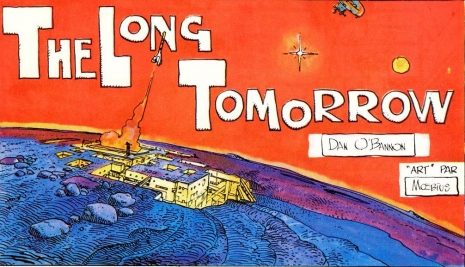
In 1975 the cartoonist Jean Giraud, a.k.a. Moebius, was in Paris collaborating with Alejandro Jodorowsky on the never-completed adaptation of Frank Herbert’s novel Dune, a project that at various times involved H.R. Giger, Mick Jagger, Salvador Dalí, Orson Welles, Udo Kier, Gong, and Pink Floyd. Dan O’Bannon, who had previously co-written John Carpenter’s first feature Dark Star and would later write the screenplay for Alien, was summoned to the French capital to work on the Herbert adaptation. Moebius and O’Bannon hit it off and in short order O’Bannon had proposed and also drawn a brief comic (let’s call it a short story) called “The Long Tomorrow” that would later be published with art by Moebius—interestingly, Moebius has stated that O’Bannon’s original art was skilled enough that he (Moebius) wanted to do a side-by-side edition of the story, but he could never get O’Bannon interested in the idea. Here is Giraud’s account, taken from his introduction to the work:
I drew “The Long Tomorrow” in 1975, while I worked with Alexandro Jodorowsky on a film adaption of “Dune”. Originally Douglas Trumbull was to do the special effects, but that was not to be, so Jodorowsky hired Dan O’Bannon to replace him. Dan came to Paris. Bearded, dressed in a wild style, the typical Californian post-hippie. His real work would begin at the time of shooting, on the models, on the hardware props. As we were still in the stage of preparations and concepts, there was almost nothing to do and he was bored stiff. To kill time, he drew. Dan is best known as a script writer, but is an excellent cartoonist. If he had wished, he could have been a professional graphic artist. One day, he showed me what he was drawing. It was the story board of “The Long Tomorrow”. A classic police story, but situated in the future. I was enthusiastic. When Europeans try this kind of parody, it is never entirely satisfactory, the French are too French, the Italians are too Italian … so, under my nose was a pastiche that was more original than the originals. A believer in parody, Dan continued that tradition.
“The Long Tomorrow” is unmistakably a noir set in the future, much as Blade Runner would prove to be. The protagonist of O’Bannon’s story is one Pete Club, a “confidential nose” who is tasked by a femme fatale named Dolly Vook Von Katterbar to secure a strongbox that is languishing in a public locker in a dangerous part of town. Before long, the case expands to include a shape-shifting Arcturian spy and (of all things) the president’s brain, which Club observes is smaller than expected.
Ridley Scott has asserted that Moebius and O’Bannon’s little tale had a sizable impact on the development of Blade Runner. In 1982, the same year that Blade Runner was released (and garnered disappointing box office), Ridley Scott mentioned to Harlan Kennedy his high opinion of Moebius and O’Bannon:
Yes, Mobius, I think, is marvelous––probably the best comic-strip artist in the world. We had him working a little bit on Alien, and I tried to get him involved in Blade Runner. I’d love to do a complete film with him, but I always catch him on the wrong foot. My concept of Blade Runner linked up to a comic strip I’d seen him do a long time ago; it was called “The Long Tomorrow,” and I think Dan O’Bannon wrote it. His work on that was marvelous, because he created a tangible future. If the future is one you can see and touch, it makes you a little uneasier, because you feel it’s just round the corner.
Below we have some selected images from “The Long Tomorrow,” but if you want to read the whole thing (it’s fun!), then you should drop by the website of a certain passionate Star Wars fan from Brazil and read it.


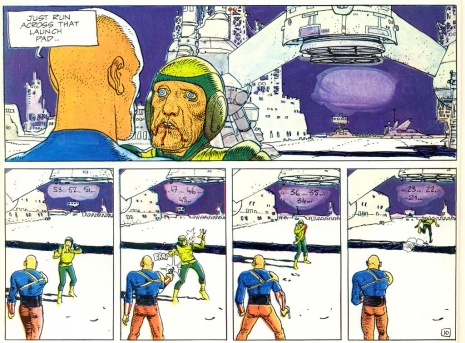
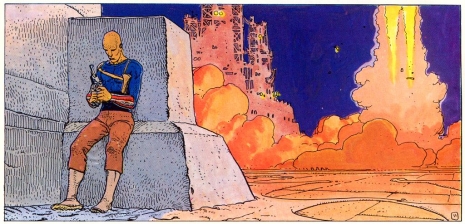
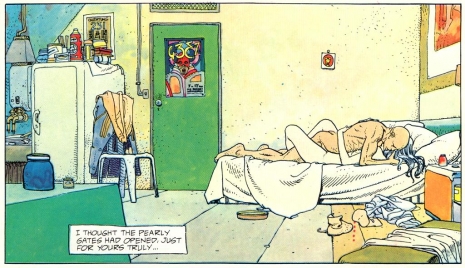
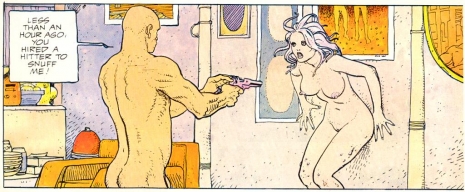
via Brandon Graham
Previously on Dangerous Minds:
‘Moebius Collector Cards’: Gallery of Moebius trading cards from the early 90s